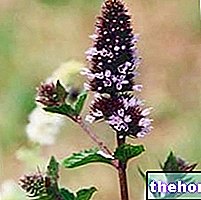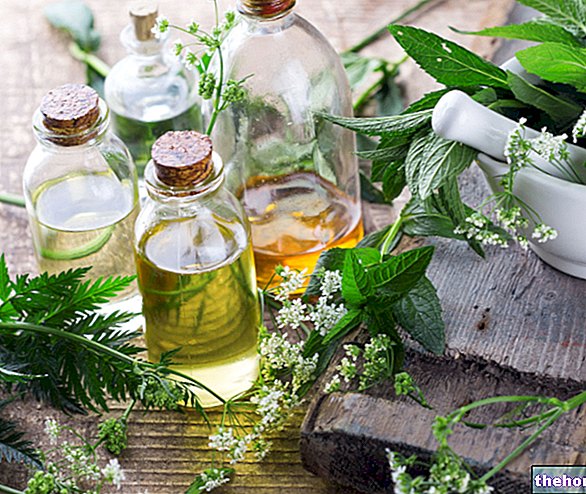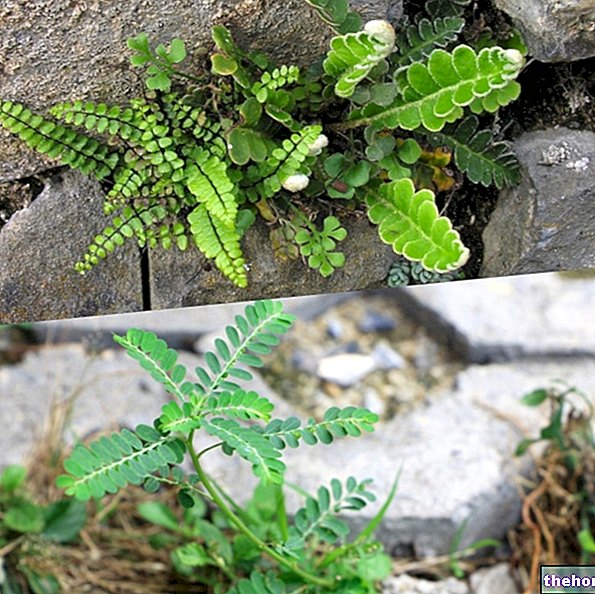See also: thyme - gland - Thyme and thyme essential oil
Thymus vulgaris L.
Fam. Lamiaceae (Labiatae)
Fr Thym
Ing Thyme
Sp. Tomillo comun
Ted Thymian
COMMON NAMES: Tummu, Tumetti (Lig.) Timi (Piem) Erba Salterella, Timm (Lomb) Peerel (Ven) Temu, Tem (Em) Peparello (Mar) Amorino (Umb) Tuma (Abr) Tumu (Pug) Peperna (Camp) Serapodda (Bas) Timu, Tumineddu (Sic) Tumbu, Arrigamu (Sard)
Description
The common thyme is a 20-60 cm tall suffrutice, with a bushy habit and branched stems that tend to lignify after 4-5 years of life.

Leaves: the thyme has opposite leaves, dotted, briefly petiolate, with the margin rounded downwards, almost sessile, lanceolate, gray-green in color, paler on the underside due to the presence of hairs. There are abundant protective hairs, including typical knee-folded hairs and sessile secretory hairs of a yellowish brown color with a head of 12 cells
Roots: The root system is bundled and has a woody consistency.
Flowers: The flowers are small, tubular, of a violet red color, grouped in spikes at the axil of the leaves. They have a velvety calyx, tubular in shape and ends in two lobes, the corolla is bilabiated, with a straight and fringed upper lip, l " lower trilobate, 4 didynamus stamens. Flowering occurs from June to September.
Fruit: it is a tetrachenium made up of ovoid cocci
Taste: The thyme leaves have a bitter taste and an intense camphor aroma.
Areal
Thyme is native to the western Mediterranean region. It grows spontaneously throughout the Mediterranean area up to 1500 m. It prefers calcareous and well-drained soils. It grows well in sunny places and does not tolerate wet and cold winters.
It is grown in France, Spain, Greece, Portugal and the United States.
Culture
Duration of culture: Thyme culture lasts 3-4 years as the plant tends to lignify. In colder climates it behaves like an annual since it hardly exceeds the rigors of winter. In these environments, in the autumn period, mulching is done as a preventive method.
Sowing: the planting is carried out using cuttings in spring or by division of the head. The sowing of the thyme, which can be carried out directly in the open field using 5-6 kg / ha of seeds, is an unusual practice due to the small size of the seeds. , which does not allow for a uniform crop.
It is preferable to sow in seedbeds in March, using 1 g of seeds per m² of seedbed; an area of 50-60 m² is sufficient to produce the plants necessary for one hectare of cultivation.
The next transplant is carried out in autumn, in milder climates, or at the beginning of spring, in colder ones. The 5-7 cm tall plants are used.
The layout of the plants is in rows spaced 50-60. The optimum crop density should be around 10 plants per m².
Requirements: thyme is considered an undemanding plant in terms of fertilizations.
Adversity: cryptogamic in nature: Alternaria oleracea Milb, which damages the fruits, Puccinia menthae Pers, and Aecidium thymi Fuck, which attack the leaves.
Harmful insects: some foliar miners are mentioned, including the larvae of a moth (Tortrix pronubana Hb.) And a nematode (Meloidogynehapla Chitwood) which damages the underground system.
Weeds: The crop is subject to being parasitized by Cuscuta epithymum (L.).
Drugs: they are the flowered tops, and the leaves from which the essential oil of thyme is extracted. The typical smell is strong and aromatic, due to the presence of thymol, the taste is slightly spicy. It also contains carvacrol, p-cymene, borneol and pinene. Conservation: the tops are dried in the shade in a well-ventilated place on top of sheets in order to collect the parts that come off during drying.
Collection and yield: the harvest of thyme is carried out at the time of full flowering if the product is intended for distillation by mowing at a height of 5-10 cm from the ground, in order to remove as much as possible the basal leaves richest in essential oil; while , if the harvest is aimed at herbal use, it is preferred to intervene at the beginning of flowering in June-July, cutting the flower stems at 5-10 cm, below the flowers. A good crop can provide an annual yield of 5- 6 t / ha of fresh product. The dry yield is around 35%. The essential oil yield of the whole fresh plant is 0.5-0.8%. Thyme reaches its maximum production in the third year of planting.
Uses
Herbal and Phytotherapeutic: the infusion is a remedy against asthma, hay fever and all allergies; in small doses it is also used for intestinal fermentation and catarrhal affections of the respiratory system.Decoctions and infusions are used to cleanse small sores and wounds and for disinfection of the oral cavity. In fact, it has bactericidal activity due to the phenolic components, thymol and carvacrol which together make up 25 to 40% of the essence
Dietetic: thyme is an aromatic plant of all respect, thanks to its digestive and carminative properties it goes well with meats, fish, sauces, vegetables, liqueurs and vinegar and is used to prepare pizzas with sesame and lemon. Herbal teas and thyme syrups stimulate appetite and promote good liver function.
Cosmetic: energetic anti-fatigue action on the face, due to the presence of mucilage and stimulating the superficial circulation. Thyme oil can also cause allergic phenomena in cosmetic preparations.
Select plant Fir Acacia Acerola Sorrel Yarrow Yarrow Yarrow Aconito Adatoda Garlic Agnocasto Agrimonia Alchemilla Alkekengi Aloe Altea Witch Hazel Ammi or Visnaga Pineapple Andrographis Anemone Pulsatilla Angelica Anise Star Anise Japanese Star Anise Bitter Orange Bitter Areca Arnica Harpagophytum Arpagophyte Artemisia Asteragus Basil Asparagus Asparagus Peruvian Asparagus Asparagus Asparagus Hawthorn Boldo Borage Shepherd's Purse Boswellia Bucco Butea superba Cocoa Coffee Cajeput Calamus Calamus Marigold Camedrio Chamomile Roman Chamomile Camphor Cinnamon Ceylon Maidenhair Capuchin Artichoke Cardamom Cardiac Thistle Asian Thistle Carvi Cascara Cassia Catecu Catha Cabbage Celandine Chicory Centaurea Cinnamon Cypress Celandine Chives Cypress Coca Cola Colchico Combreto Condurango Comfrey Coriander Cranberry Barberry American Chrysanthemum Cumin Turmeric Damiana Digital Dioscorea Drosera Dulcamara Dunalilella Echinacea Eder a Ephedra Elenio Eleutherococcus Helichrysum Evening primrose Horsetail Alfalfa Erica Euphrasia Erisimo Escolzia Eucalyptus Farfara Farfaraccio Calabar bean Fenugreek Fennel Phytolacca Frangola Ash Fumaria Japanese Mushrooms Galega Ganoderma lucidum Garcinia Cambogia Mulberry Gentian Broom Ginkgo Ginkgo Guipana Guipana Gynestra Ginkgo Hibelia Gymnasium Hibiscus Guarulp St. John's Wort Horse Chestnut Ispaghul Hyssop Jaborandi Kava kava Konjac Laminaria Cherry Laurel Lavender Lemongrass Lespedeza Lovage Icelandic Lichen Lemon Flax Lippia Licorice Lobelia Hops Maca Marjoram Maize Mallow Manna Marrubio Marrubio d "water Matè Melaleuca Meliloto American Lemon balm Myrtle Myrama Walnut Nutmeg Walnut vomica Olive tree Meadowsweet Ononide Opuntia Oregano Orthosiphon Nettle Poppy Papaya Parietaria Feverfew Passiflora Chilli Perilla Periwinkle Phyllanthus Plantain Picrorhiza Pilosella Pino Pisci dia Podofillo Polygala Grapefruit Parsley Psyllium Pueraria mirifica Butcher's broom Pygeum Quassia Oak Rhubarb Ratania Rauwolfia currant Castor bean Rhodiola Rosehip Rosemary Rue Willow Sarsaparilla Sage Elderberry Sassafras Sedum Ergot Senna Serenoa Repens Soybean Solidago Tansy Taraxus Tamarind Tamarind Tamarind Tamarind Tamarindo Ursina Valerian Vanilla Mullein Verbena Veronica Viburnum Vinca Pansy Mistletoe Vine Withania Yohimbe Saffron Ginger Pumpkin Select disease Juvenile Acne Rosacea Tinnitus Tinnitus Aerophagia Tendon Affections Afonia Aphthae Algias Functional Halitosis Breastfeeding Allergy Anemia Anguish Anxiety Arteriosclerosis Asthrosis Asthrosis Arthritis Arthritis Men Sex Woman Blepharitis and Conjunctivitis Eye bags Bronchitis Gallstones Kidney stones Salivary stones Baldness Androgenetic Candida Fragile hair Caries Headache Cellulitis Motion sickness Cystitis C limaterio Cholecystopathy High cholesterol Ulcerative colitis Colonoscopy Contusions Hematoma Convalescence Couperose Depression Dermatitis Diaper dermatitis Diabetes Diarrhea Erectile dysfunction Dyslipidemia Dysmenorrhea Dyspepsia Disturbances of vision Hemorrhoids Epistaxis Herethism Heart disease Fever Fibromyalgia Gastro-intestinal disease Flatulence Hypertension Fibromyalgia Gastrointomnia Jaundice Laryngitis Renal lithiasis Toothache Sore throat Thinness Menopause Meteorism Mononucleosis Alzheimer's disease Crohn's disease Nausea Vomiting Obesity Dark circles Onychomycosis Osteoporosis Dry skin Periarthritis Piorea Low pressure Prostatitis Psoriasis Colds Breast fissures Anal fissures Gastro-nasal rhinitis Senescence Premenstrual Syndrome Sinusitis Quit smoking Overweight Fatty liver Constipation Stomatitis Stress Cough Triglycerides high Ulcer Burns Nails Brittle flashes Heat Warts Dizziness Properties herbal Tanning Abortive adaptogenic Aphrodisiac bittering analgesic anesthetic anorectics analgesic antacid anti-allergic anti-asthmatic Antibiotic catarrh Anticellulitiche anticonvulsant Antidiaforetiche antidiarrheal edematous anthelmintic antiemetic Antiemorroidarie antiphlogistic Antiidrotiche Antinevrotiche Antioxidants antipyretic antirheumatic antiscorbutic Antiseptic antispasmodic anti-uric Aperitive Flavoring Astringent Balsamic Bechiche Capillarotrope Cardiotonic Carminative Cathartic Caustics Healing Cholagogues Choleretic Dyes Decongestants Deodorants Purifying Diaphoretic Cleansers Disinfectants Detoxifiers Thirst quenching Diuretics Exciting Emetics Emmenagogues Emollients Hemostatic Energies Hepatoprotectors Expectorants Eupepticus Moisturisers Galactosensitizers lanti Hypertensive Hypnotic Hypoglycemic Hypotensive Irritants Laxatives Soothing Narcotic Nerves Nutrients Odontalgic Pectoral Purgative Revulsive Remineralizing Refreshing Rubefacient Scialagoghe Sedative Soporifugas Sneezing Stomachic Stomatics Narcotic Vascular Tightenitis




























